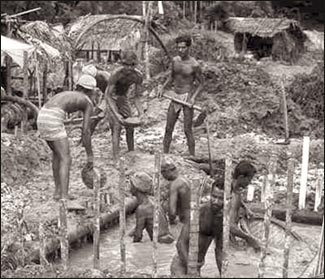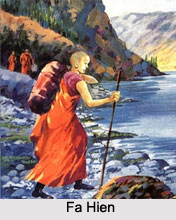Sri Lanka was anciently known as Taprobane, which means copper colored in Greek. The indigenous Veddahs noticed colored rocks splayed across the sandy bottoms of the river they used to bathe in. This was before the Buddhist monks began adorning crude jewelry with these stones. Ancient Chines and Greek historians mentioned about the attractive gems of Ceylon which were used repeatedly by King Solomon to woo the Queen of Sheba. The term ‘mani’ jewel originated from the Sinhala and Sanskrit words- manikya or menik.

History proves that gem industry flourished in Sri Lanka even in the past and gems had been ranked a major export item then. The use of precious stones in decoration purposes can be identified in varied forms when ancient rulers had ascribed a great value to them. Most obviously, precious stones were lavishly exploited to embellish palaces, religious places and they were stored up as valuable things in royal treasure houses. The rulers and the royalty wore the jewellery studded with gems and there were villages of gem cutters who manufactured jewellery and attractive precious stones for those of the higher classes.

There is an interesting account of a group of people called Mukkuwars who were closely connected with precious stones. This unique ethnic group probably immigrated to Sri Lanka from India or some Arabian country in order to seek wealth hidden in Sri Lanka – the precious stones.
Scattered legends associated with the operations of Mukkuwars in Sri Lanka narrate their strange practices in excavating the ground for signs of gems. They definitely found gems in some sites and regions because they applied their own science to locate earth with gems. In keeping with the popular legends, Mukkuwars worked hard excavating the earth for gems and if ever one of them died, they would bury him along with his own valuables and precious stones.
Therefore, the graves of Mukkuwars were subsequently believed to be treasures in the earth. This practice reminds us of the Pharaoh tradition of keeping precious objects loved by a dead ruler alongside the dead body inside the pyramid.
According to the chronicles, Sri Lankan gem industry has a very long history and dates back even before the 6th century B.C… It is one of the oldest industries, which for centuries has supplied the gem market with a large number and wide variety of Gemstone which still plays a major contribution to Sri Lankan economy.

Various references to the precious gems of Sri Lanka are found in many historical records of the island. One of the records being of the “Buddhist Countries” (around 412 A.D.) by Fa-hsien, the Chinese Buddhist monk states “… there is a district of about 10 square limit which produces the mani jewel. The king has posted guards here, and takes a levy of three tenths of the jewels that are found.”
Marco Polo’s recorded visit in the year 1292 states that, “I want you to understand that the Island of Ceylon is for its size, the finest island in the world, and from its streams comes rubies, sapphires, topazes, amethyst and garnet.” Apart from overpopulation and a faltering economy, not much has changed of Sri Lanka since Marco Polo’s time.
Another record, “The Historic Tragedy of the Island Of Ceylon” (1685 A.D.) by Joao Ribeiro, a Portuguese Army Captain. His Description of Sri Lanka’s gems states “…Here are all the valleys and mountains that are full of them and are obtained with little trouble; such as rubies, the finest that can be found anywhere within our discoveries, all in separate crystals; sapphires, topazes (some of them of extraordinary size) cat’s eyes…garnets, beryl, jacinth, tourmalines and various others, which are held in no account there, since they are the stones with which the river beds are furnished”
Buddhists from north India were travelling to Sri Lanka and came across the precious gems while bathing in the rivers and streams of the island. The corrosion of the rocks gave rise to extended deposits loaded with precious gems in the riverbeds of streams located in valleys at a lower altitude. These attractive gems adorned their frequently worn accessories like rings, bracelets and armlets. These stones were then traded throughout their travels in different parts of Asia and Europe. That is how the gems of Sri Lanka came to be known in different parts of the world.
Portuguese period
The gems found in any region of the country were considered state property during the Portuguese period. There were special officials appointed by the state to supervise the work of obtaining gems in rivers and mines during this period. There were officials such as Akara Vidane, Kanaka Pulles and Mohottalas who were in charge of gem mining and they were supported by a few experienced gem miners.
During the Portuguese period, mining for gems took place within the spell from January to April, in addition to mining, gem cutting too was a major industry in the country and the Portuguese accumulated immense wealth that was chiefly invested in their colonial projects, according to their documents. Historical writings made by foreign travellers provide a great deal of information regarding the use of precious stones in the period. The Portuguese made arrangements to sell the gems found in Sri Lanka at special gem markets in Kochin and Gova.
According to the records made by John Dave, all the gems found in the country was a property owned by the king in the Kandyan Kingdom. During this period, gem mining took place under the permission and supervision by the king who used the gems to decorate the palace and religious institutions. The precious stones were chiefly used to embellish the king’s crown, ear rings, throne, bracelets and certain statues in the palace. Dave reveals in his writings that the common precious stones found in Sri Lanka were blue sapphires, rubies, tourmalines, quartz, amethyst, garnets and topaz. Some of these were semi precious stones.
John Dave claims that the king and the royalty lavishly exploited gems for varied projects and goes on to say that the kings presented gems and jewellery to the most gifted officials and foreign envoys. The kings in their coronation wore a special gold plated garment inset with the best precious stones such as rubies, sapphires, diamonds and topaz.
The king sometimes carried a stick decorated with precious stones and had his armed vehicles studded with (semi) precious stones such as garnets or quartz. During this period, cutting and polishing of gems had been widespread among many districts and the cut and polished gemstones were fixed on (royal) garments and ornaments.
Gems were inserted into the eyes of ancient Buddha statues and there have been traditions to insert gems to many parts of a statue or even to the aureole of Buddha statues. The crown of Sri Lankan kings bears the marks of having been extravagantly embellished with gems. The elaborate crown worn by Sri Wickrama Rajasinghe (which is kept on display in the National Museum) speaks volumes for the practice of fixing many gems on the crown worn by Kandyan kings such as Sri Wickrama Rajasinghe, and king Wimaladharmasuriya.
